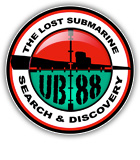Ship
Identification
The case for USS BURNS (DD-588)
We have
compelling evidence that the Fletcher Class Destroyer
discovered at San Clemente Island is the
USS BURNS (DD-588). We
reached this conclusion based upon a thorough process of
elimination as well as confirmation by two independent
sources. Our analysis is described below.
On December 12, 2009 a sunken U. S. Navy Fletcher Class
destroyer was found off the coast of San Clemente Island,
California, the apparent victim of a Naval exercise. Basic
configuration of the vessel and in particular, evidence of
three 5-inch guns in the aft section of the wreck, are
unique to this class of ship. We also observed that the
ship had a square bridge, a single pole main mast and two
torpedo tube foundations. Furthermore, the ship was missing
her No.2 and No.5 5-inch gun turrets along with her forward
set of torpedo tubes. This armament must have been removed
from the ship prior to her disposal. This specific
combination of features was essential in the ship's
identification.
We immediately checked the location of the wreck with the
California State Lands Commission. They returned the name
of former U. S. Navy destroyer USS BURNS (DD-588), Sunk
June 30, 1976, in the same general vicinity.
On December 27, 2009 we learned from diver Jim Carver,
former crew member of USS HULL (DD-945),
that HULL sank a target ship at San Clemente Island
sometime in 1976. The target ship was being used to test
the effectiveness of the Navy's new Mk 71 8"/55 Major Caliber Lightweight
Gun (MCLWG),
the first major caliber weapon to be installed on a U.S.
Navy destroyer. Jim also recalled the name of the target
ship as USS BURNS (DD-588). That was great news, or so
we thought.
Based
upon the CSLC listing of BURNS being sunk in June 1976 in
combination with Jim Carver’s eyewitness account of
her sinking, we began digging into the fate of the
BURNS. What we found was conflicting
information. We found references to BURNS’ sink
date as both 20 June and 20 September, 1974. How
could this be? As we started digging further, we
found numerous cases where the sink dates of various
destroyers conflicted with photographs showing the ships
afloat subsequent to the listed sink date. We
concluded that, in some cases, the “sink date”
was really the date the ship was designated as a target for
sinking. In other cases, the sink dates simply appear
to be wrong. We obviously needed to start from
scratch with a thorough process of elimination.
On January 9, 2010, we had the good fortune of being
contacted by CDR Paul J. Piper, USNR-Ret. CDR Piper was the
former Gunnery Officer aboard USS HULL during testing of
the Mk 71 8"/55 gun. CDR Piper vividly recalls the events
of that day more than 30 years ago. In fact, he personally
fired the guns that sent the target ship to the bottom.
Unfortunately he doesn't recall the name of the target
ship. He was able to accurately describe the location,
orientation and condition of the wreck, which were
confirmed during our dives on December 12, 2009 and January
2, 2010. There is no doubt that the ship we found is the
same ship that HULL fired on and sank.
On January 11, 2010 another key piece of information came
to us from Leo Fisher, one of the project engineers
assigned to the the Mk 71 8" MCLWG Program.
"As
to the destroyer the HULL sank, that was part of
a guided projectile test conducted on June 22, 23 and 29
1976. The five hits were with the 8" paveway GP.
Actually we were not supposed to sink the target, but the
laser spot on the hull reflected down on the water and
a round hit low and put a hole below the water line and we
were stuck with a slowly flooding target. We had to
pump about 50 rounds of 5-inch into the target before
it finally sank. I don't remember the hull number of
the target.”
"CNO Project 186, consisting of ten Eight-Inch Unpowered
SAL Guided Projectile firing tests from the USS Hull
(DD-945) Mk 71 Major Caliber GP's (as well as 24 nonguided
rounds, consisting of nine Ballistic Shapes and fifteen
conventional rounds) were fired against shore and seaborne
targets. Two GP's were fired at a bunker target (MULE
Laser - 13 KYD firing range), two at a stationary truck
(MULE Laser - 13 KYD firing range), one at a moving tank
(Spot Laser - 16 KYD firing range), and five at an
ex-destroyer target HULK (13 to 16 KYD firing ranges)."
Above quote from: Major Caliber Lightweight Gun Integrated
Development Plan, Feb. 1978.
“All five rounds fired at the hulk were hits.
No mention of the name of the hulk target but at
least we now know exactly when the tests took
place."
We started our process of elimination by examining the
reported fate of all Fletcher Class ships ever built (175).
From this list, we first eliminated all ships with a
rounded bridge (58). We then eliminated all ships sunk
during WWII (13), sold or scrapped (46), transferred to
foreign navies (38) or museum ships still afloat (3). From
this we were left with all ships sunk as targets (17). We
then eliminated those ships which had specific
modifications. These modifications included conversion of
the single pole main mast to a tripod mast (13) and the
replacement of the forward quintuple torpedo tubes with
twin quad 40mm anti-aircraft guns (1). Finally we
eliminated any remaining ships sunk after June 1976 (1).
This process reduced the number of possible ships from 175
to 2. The two ships remaining on the list are USS BELL
(DD-587) and USS BURNS (DD-588).
USS BELL has officially been eliminated. See update
below.
Analysis of square bridge Fletcher Class
destroyers
The
combination of physical and dispositional data used in our
analysis precludes all Fletcher Class destroyers other than
BELL and BURNS. BELL and BURNS share many of the same
physical features. We know BELL had its forward tubes
removed prior to July 1969 and at least its number 5 turret
removed prior to March 1973. We also know BURNS had its
forward tubes removed prior to 1969 and turrets 2 and 5
removed prior to January 1974. Both ships were approved for
transfer to Pt. Mugu from San Diego in 1972 for
disposal as
part of the Harpoon Missile Test program.
Is it possible we found the BELL and not the BURNS? Yes,
but if BELL's reported sink date of 11 MAY 1975 is correct
then BELL must be eliminated from the list, leaving BURNS
as the only remaining ship.
USS BELL has officially been eliminated. See update
below.
There is still hope of making a positive ID directly from
the wreck itself. All Fletcher Class destroyers had their
names welded on the transom just below the stern chock. The
dive team will take a closer look for the ship’s name
in the future.
We have additional research requests pending from the
National Archives. We will post new information on this
page as it becomes available.
UPDATE: MARCH 10, 2010 - Today we received the deck logs of
USS HULL (DD-945) from the National Archives.
Unfortunately, the name of the target ship was not recorded
in the log. The log does confirm the date of sinking as 29
JUNE 1976. USS HULL Decklog 29 JUNE
1976
UPDATE:
APRIL 27, 2011 - The
official disposition of USS BELL (DD-587) was received
today from the Navy. USS BELL was sunk by aircraft 40 NM
west of San Clemente Island on 11 MAY 1975. This new
information positively eliminates USS BELL from our list,
leaving USS BURNS as the only remaining ship.
USS BELL
Disposition
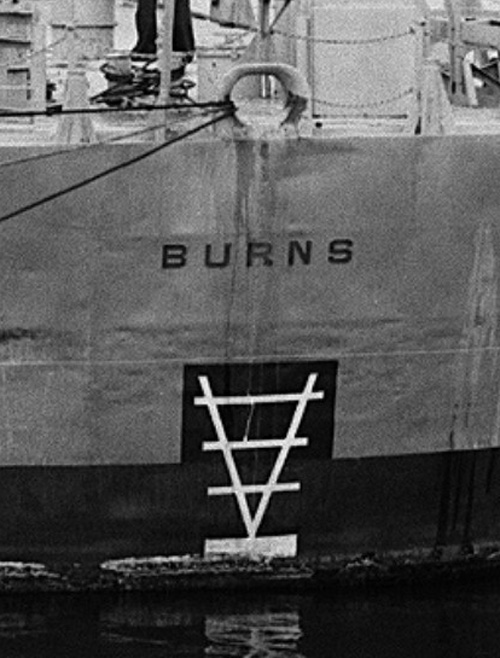
A
close up of the welded letters on the transom of USS BURNS.
This is likely the only place where a positive
identification can be made directly from the wreck. This
photo was taken on 12 MAR 1973 at the reserve anchorage,
San Diego, CA. Photo by Larry Cote.
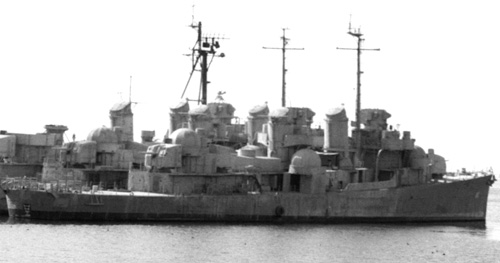
Starboard
view of USS BURNS (DD-588) taken on 29 JAN 1974 in the
reserve anchorage, San Diego, CA. Photo clearly shows her
No.5 5-inch gun has been removed. Photo by Larry Cote.
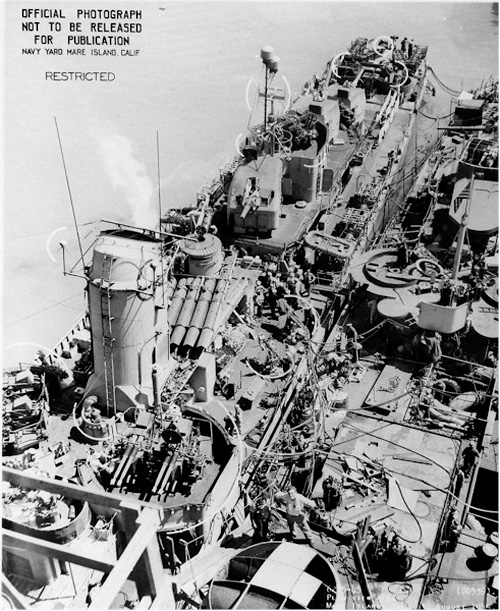
This
view of USS TINGEY DD-539 shows the installation of twin
quad 40mm anti-aircraft guns in place of the forward
quintuple torpedo tubes. The wreck found at San Clemente
Island does not have this modification.
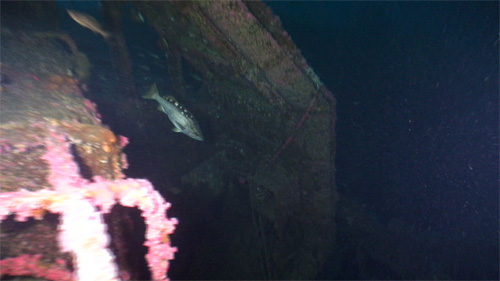
The
angled construction of the bridge indicates that this is a
square bridge model. All round bridge Fletchers were
eliminated. Photo by John Walker.
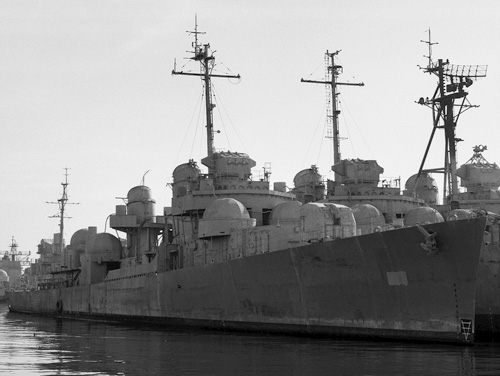
Larry
Cote took this photograph of BURNS from aboard a Navy
launch on 29 JAN 1974. This view clearly shows her square
bridge and single pole mast. Her No.2 5-inch gun has also
been removed. Her hull number has been painted over prior
to disposal. BURNS departed San Diego for Pt. Mugu on 5 JUN
1974.
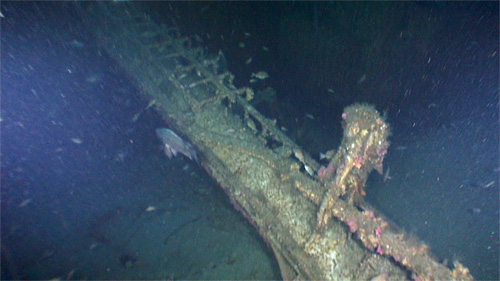
The
destroyer has a single pole mast. All tripod mast Fletchers
were eliminated. Photo by John Walker.
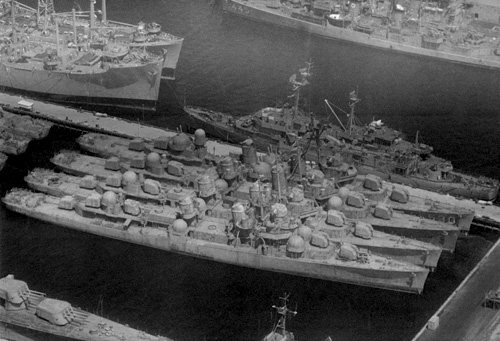
Four
Fletcher Class destroyers moored at Pier 10, NISMF San
Diego, CA in July 1969. From the ship closest to the
camera: HALFORD DD-480, WILEY DD-597, BURNS DD-588 and
TRATHEN DD-530. Photo and ship identification courtesy of
Larry Cote.
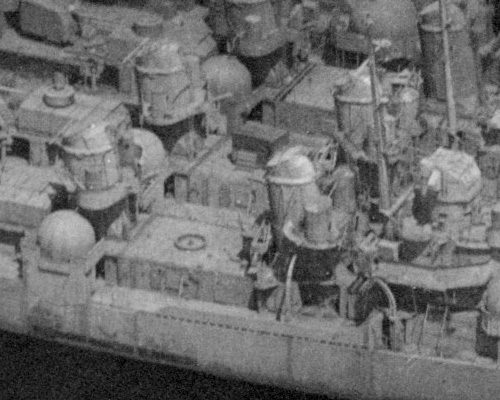
An
enlargement of the preceding photo. Note the forward
torpedo tubes have been removed between the stacks of
HALFORD, WILEY and BURNS. Photo courtesy of Larry Cote.
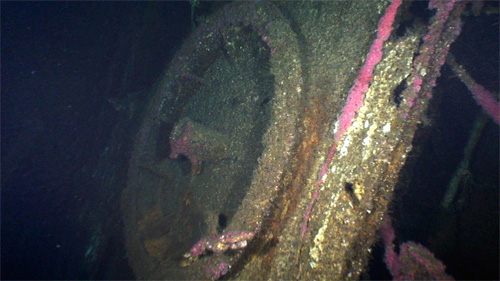
Forward
torpedo tube foundation, confirmed by builder’s
drawings (below), indicates that this ship was never
modified for quad 40mm anti aircraft guns. All mid-ship
twin quad-40mm modified destroyers were eliminated. Photo
by John Walker.
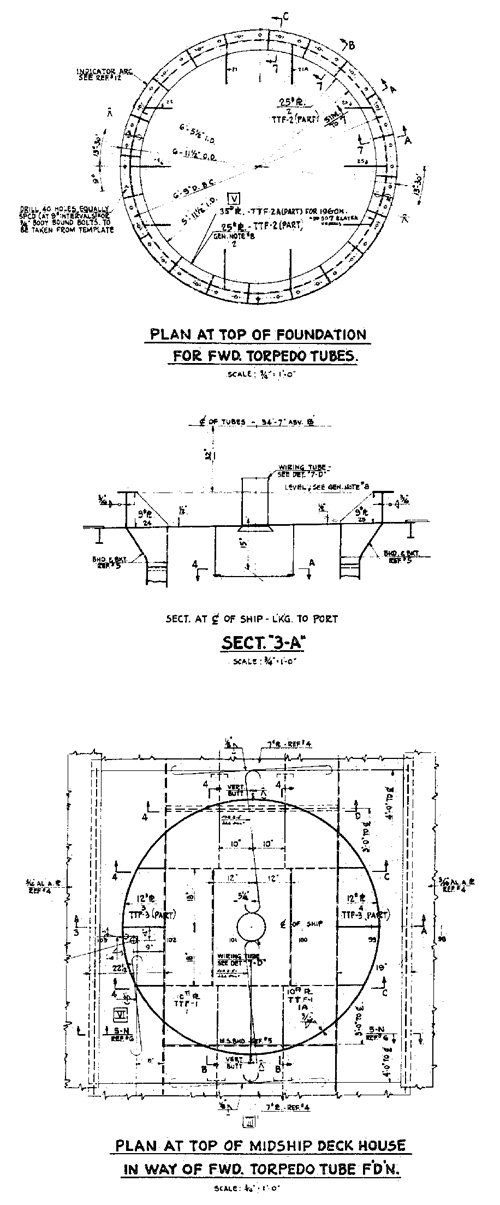
Builder’s drawing of forward torpedo tube foundation.
Courtesy of Dave McComb at destroyerhistory.org
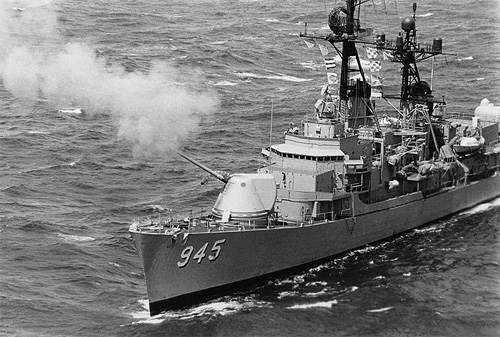
USS HULL (DD-945) test firing the Mk 71 8” gun. US
Navy photo NH 98310.
Statement
from Jim Carver
Crew Member USS HULL
“I recall that the USS BURNS was sunk during
testing of the USS HULL’s new 8" gun. Using inert
(sand filled) laser guided shells the bridge was first
targeted, then the waterline, sinking the target quite
unexpectedly. I was a sonar tech on the HULL starting in
the fall of 75 until the winter of 77. Testing of the Mk 71
started in 75. At that time all of the testing was
targeting San Clemente Island itself. This lasted into
early 76 when shipboard damage from the intense recoil of
the Mk 71 became a problem (It was a nightmare for my tube
based AN-SQS-23 sonar system). In the spring/summer of 76
we resumed live fire to test the new laser guided rounds,
again this was initially on land based targets, then
finally on a "real" target, which I vaguely remember as the
BURNS.”
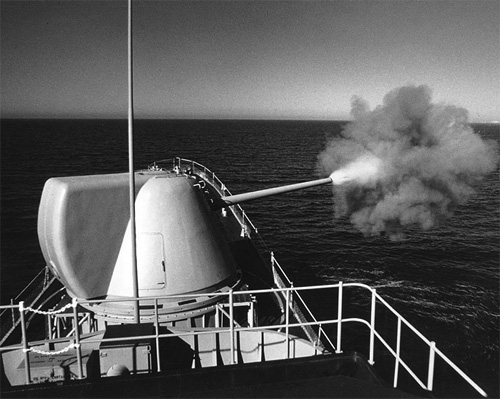
Close up of Mk 71 8” gun 17 SEP 75. Photo by
Photographer's Mate 1st Class Carl R. Begy
Statement
from CDR Paul J. Piper, USNR-Ret.
“I was the Gunnery Officer who sank the Fletcher
class destroyer at San Clemente Island. We were not
only using the 8” 55 Cal. gun but we were testing a
laser guided projectile. My first laser shot put a
large hole through the bridge area which would have taken
out her control area if it were an enemy
combatant. As the sun was going down the
captain told me to finish off the target ship with all
three guns from close in as he didn't want to leave a
floundering vessel as a hazard to navigation. We
pulled around to about 4,000 yards; 2 nm and I had one
trigger in one hand for the 8" gun and one trigger in
the other for the 2 5" guns aft. I was sitting in the
gun director which is located high above the bridge.
Even though the target ship had all of her fuels removed
flames shot up more than 100 ft. as I sent shell after
shell into her engine room pulling the triggers as fast as
the guns would load. My last shots that sent her to
the bottom were below the waterline or close to it.
She went under by the stern with a large cloud of
smoke. There should be 20 to 25 hits on her.
Unfortunately I don't recall her name or exactly when she
went under. I am in contact with some of my old
gunners mates and they might have the answers.
The target ship was secured by anchors bow and stern.
In thinking about it, the ship was probably just 2,000
yards from shore. We did use live rounds from the 5"
54's but we may not have set the HE fuses. I just
don't recall if we used HE (High
Explosive). All the holes going into the ship
would be from the starboard side. I never put any
rounds through the port side. I do remember when I
finished her off we were at 2 nm. It had to take at
least 1/2 hour or more to sink her as we started about 4 or
5 nm. and we had to get down to 2 nm. I also shot a
concrete bunker on San Clemente Island with armor piercing
rounds and an army 6x6 truck with a 60 ft. air
detonation. Even the engine block on the truck was
peppered with holes. They also set up a large
target painted on canvas on the side of the island.
On the third shot I hit the target dead on. We also
shot an orange target ship out in the open ocean. It
was a real long shot as I recall. Probably 7 or 8 nm
as I could barely make it out from the gun director with
high powered optics. 1976 was probably pretty close
as we deployed to the Far East for 7 months after
that. It was probably the spring/summer of
1976.”
Acknowledgements
We gratefully acknowledge all who responded and assisted us
in our research on this project. Many shared with us their
personal recollections. We could not have learned many of
the details without their cooperation. Thank you very much.
(In
Alphabetical Order)
Randy C. Andrews - USS HULL
Jim Carver - USS HULL
Kim Christiansen - USS HULL
Lou Colella - USS Hull Association
Historian
Larry Cote - Photographer and Naval Historian
Rick E. Davis - Naval Historian
Carl Decker - USS HULL
Harold Decker - USS BURNS
Tony DiGiulian - NavWeaps.com
Tom Ferstl - USS HULL
Leo Fischer - Mk 71 Project Engineer
Pamela Griggs - California State Lands
Commission
Terry Hamill - USS HULL
Brent Jones - Mighty90.com
Dave McComb - Destroyerhistory.org
Terry Miller - Tin Can Sailors,
National Association of Destroyer Veterans
CDR Paul J. Piper USNR-Ret - Gunnery Officer USS HULL
Paul Thayer - California State Lands
Commission
Matt Van Haren - USS HULL
